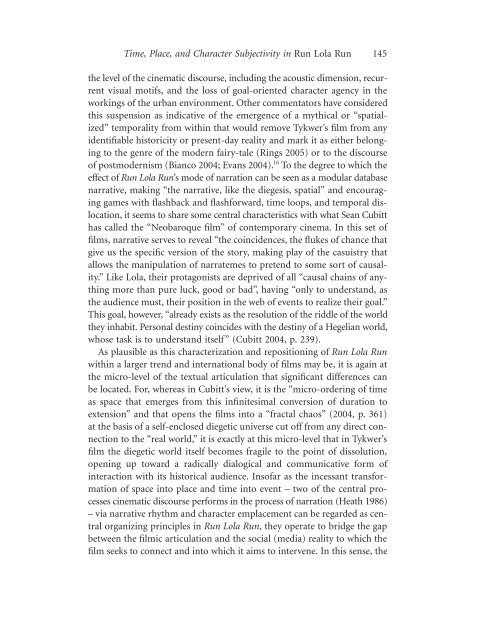Buckland-Warren-Puzzle-Films-Complex-Storytelling-Contemporary-Cinema
Buckland-Warren-Puzzle-Films-Complex-Storytelling-Contemporary-Cinema
Buckland-Warren-Puzzle-Films-Complex-Storytelling-Contemporary-Cinema
You also want an ePaper? Increase the reach of your titles
YUMPU automatically turns print PDFs into web optimized ePapers that Google loves.
Time, Place, and Character Subjectivity in Run Lola Run 145the level of the cinematic discourse, including the acoustic dimension, recurrentvisual motifs, and the loss of goal-oriented character agency in theworkings of the urban environment. Other commentators have consideredthis suspension as indicative of the emergence of a mythical or “spatialized”temporality from within that would remove Tykwer’s film from anyidentifiable historicity or present-day reality and mark it as either belongingto the genre of the modern fairy-tale (Rings 2005) or to the discourseof postmodernism (Bianco 2004; Evans 2004). 16 To the degree to which theeffect of Run Lola Run’s mode of narration can be seen as a modular databasenarrative, making “the narrative, like the diegesis, spatial” and encouraginggames with flashback and flashforward, time loops, and temporal dislocation,it seems to share some central characteristics with what Sean Cubitthas called the “Neobaroque film” of contemporary cinema. In this set offilms, narrative serves to reveal “the coincidences, the flukes of chance thatgive us the specific version of the story, making play of the casuistry thatallows the manipulation of narratemes to pretend to some sort of causality.”Like Lola, their protagonists are deprived of all “causal chains of anythingmore than pure luck, good or bad”, having “only to understand, asthe audience must, their position in the web of events to realize their goal.”This goal, however, “already exists as the resolution of the riddle of the worldthey inhabit. Personal destiny coincides with the destiny of a Hegelian world,whose task is to understand itself” (Cubitt 2004, p. 239).As plausible as this characterization and repositioning of Run Lola Runwithin a larger trend and international body of films may be, it is again atthe micro-level of the textual articulation that significant differences canbe located. For, whereas in Cubitt’s view, it is the “micro-ordering of timeas space that emerges from this infinitesimal conversion of duration toextension” and that opens the films into a “fractal chaos” (2004, p. 361)at the basis of a self-enclosed diegetic universe cut off from any direct connectionto the “real world,” it is exactly at this micro-level that in Tykwer’sfilm the diegetic world itself becomes fragile to the point of dissolution,opening up toward a radically dialogical and communicative form ofinteraction with its historical audience. Insofar as the incessant transformationof space into place and time into event – two of the central processescinematic discourse performs in the process of narration (Heath 1986)– via narrative rhythm and character emplacement can be regarded as centralorganizing principles in Run Lola Run, they operate to bridge the gapbetween the filmic articulation and the social (media) reality to which thefilm seeks to connect and into which it aims to intervene. In this sense, the


